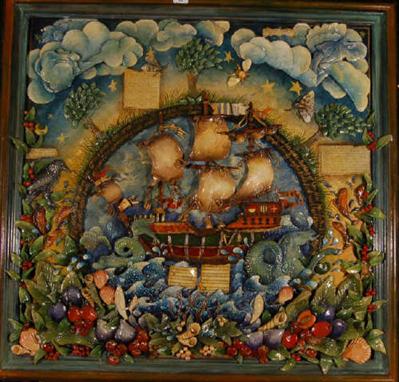We found 13587 price guide item(s) matching your search
There are 13587 lots that match your search criteria. Subscribe now to get instant access to the full price guide service.
Click here to subscribe- List
- Grid
A group of assorted 20th century pictures and prints, including an ink nude study signed O.Beguel `64, a small etching of an embracing couple, a grey collage landscape, a composition signed V.Guiro, an aquatint of a still life with coffee pot indistinctly signed, and a head study of a girl. (5)
PIETRO PSAIER (1936-2004) ITALIAN, LAST STOP USA, MIXED MEDIA PHOTO COLLAGE. Pietro Psaier design for proposed village voice Greenwich Village magazine, rejected to photographic release of copyright. Signed Pietro Psaier. 32 x 28 inches. Exhibited: Shocking Art Show, Galleria Brussels, 1978.
PIETRO PSAIER (1936-2004) ITALIAN, REAL TENNIS. A PLAY ON WORDS, INCORPORATING VIVIEN WESTWOOD/MCLAREN AND PSAIER. Real tennis collage proof made with poppy flower handmade paper with English & Spanish tennis terms. Signed Pietro Psaier. 25 x 25 inches. Provenance: Exhibited at Soho NY Gallery, Greenwich Gallery, Chelsea Hotel.
Anne Schwegmann-Fielding, late 20th/early 21st century- "Sunflowers 1"; watercolour and collage, signed with initials, bears inscription on the mount, 57x19.5cm: Arabella Howell, late 20th/early 21st century- "Estates"; acrylic on paper: Nicholas Barnham b.1939- "Trees at Kilninian Mill"; watercolour, signed. titled and dated 1978. Provenance: with the Thackeray Gallery, London, according to label attached to the reverse of the frame: Virginia Horlley, late 20th/early 21st century- "Healing Arts, Isle of Wight"; acrylic on board: Olivia Brown, late 20th/early 21st century- "Geoffrey"; gouache: Claire Johnson- "Unity"; watercolour: Chloe Langlois, late 20th/early 21st century- "Lucy"; acrylic on paper, (7) (may be subject to Droit de Suite)
Emma Twigger, late 20th/early 21st century- "The Past Still Speaks"; acrylic, egg tempera on paper, 29x27cm: Garry Calderwood- "A Wee Dram before Bedtime"; pastel: Richard Kitson, late 20th/early 21st century- "My Yorkshire"; watercolour: June Lloyd, late 20th/early 21st century- "Mad Cows and Englishmen"; mixed media and collage: Nicola Hamilton, late 20th/early 21st century- "Belfast"; acrylic, wax and charcoal: Phillomena Allen, late 20th/early 21st century- "The London Underground"; acrylic on paper: James Leighton, late 20th/early 21st century- "Info Freak"; oil and acrylic on paper: John Caldwell, late 20th/early 21st century- "Saturday Afternoon in Guildford"; pastel: David Eland, late 20th/early 21st century- "People on Pavement"; oil on paper, (9). Provenance: Paintings in Hospitals, London (may be subject to Droit de Suite)
Pat Lambshire, late 20th/early 21st century- "Still life"; gouache , pastel and collage, 33.5x33cm: June Lloyd- Jones- "Asters"; oil on canvas board, signed with monogram: June Lloyd-Jones- "Sweetpeas"; oil on canvas board, signed: Lynn Breeze- "I Made a Birthday Card"; pen and black ink and watercolour, two, in shared mount and frame, signed twice in pencil: Lynn Breeze- "Black Drop"; pen and black ink and watercolour, two, in shared mount and frame, signed twice in pencil: Lynn Breeze- "I Made Flowers"; pen and black ink and watercolour, signed in pencil: Ann Carol Sutherland- "All The Summer Isles"; gouache and collage, signed and dated 1984 in pencil. Provenance: with The Mercury Gallery, London, according to label attached to the reverse of the frame: Laura de la Mare- "Still Life with Mackerel on a Plate"; gouache and acrylic on paper, all the above artists late 20th/early 21st century, (9). Provenance: Paintings in Hospitals, London (may be subject to Droit de Suite)
* Jirí Kolár, Czech 1914-2002- Age of Innocence; collage/froissage, signed and dated 79, 31x24cm: Note: Jirí Kolár's first exhibitions were in 1937, and in these exhibitions he displayed his collages. In 1960's he put painting and poetry together but he gradually fully turned to experimenting in visual art. In his work he used a scalpel to cut pictures out of magazines. He produced colours in his collages by gluing on printed papers. His collages were intended to influence the viewer's outlook on life; to raise the viewer's level of consciousness. He develop new techniques of collage, see, confrontage, Froissage and rollage. Provenane; ex lot 418 , 24 Febuary, 1988, Sothebys.
SIR KYFFIN WILLIAMS RA oil on canvas - a collage style depiction of the two Menai Bridges, 30 x 24 (Provenance: especially commissioned by Wales Gas in 2001 to celebrate the opening of the North Wales Gas Grid. The Board was apparently taken aback by the ingenuity of the painting, but disappointed as it had thought erroneously that the artist would have been able to depict the two bridges from the Straits in a conventional manner. The letter from the artist to the then owner illustrates Sir Kyffin's frustration at being unable to meet fully the criteria expected).
A Pair of Bird Feather Collage Pictures, circa 1840, one depicting a little bustard and a chick near a tree, the other a ring ouzel and a large thrush-like bird perched in the branches of a tree, each with painted beak, legs and claws, the background in watercolours, in golden oak frames, the images 34.5cm by 41cm See illustration
A rare Victorian Entomological Collage of aprox 600 'pinned' specimen beetles in a rosewood case The beetles are South American (possibly Costa Rica) including two Harlequin Longhorn beetles; a large Rhinoceros (Elephant' beetle). The collection has been in the same family for over fifty years since it was acquired in Wales, 47cm x 62cm
Ella Bergmann-Michel (1896-1971). Untitled. Ink . Signed, dated '22 and inscribed 'oB 134' lower right. 32cm x 45cm. Exhibited: Annely Juda Fine Art, London, The Russian Show- A commemoration, August - December 1983, No. 88 illustrated page 155; Annely Juda Fine Art, London, Ella Bergmann-Michel Collages and Drawings 1917- 1931, May - July 1884, No. 12 . Literature: Herta Wescher, Die Collage, Koeln, 1968. Visit www.dnfa.com for condition reports.
Sir Peter Blake (b. 1932). Memories of Place- Paris, 2005. Collage and mixed media. Signed and Inscribed . 'Memories of Place. 'Paris'. . A walk through the Tuileries gardens . from Place de la Concorde . to the Louvre. Peter Blake' along lower edge. 32cm x 26cm. Exhibited: Waddington Galleries, London, Peter Blake 1-10 (Collages, Construction, Drawings & Sculpture) & The Marcel Duchamp Paintings, . 19 October - 12 November 2005, Catalogue No. 8a, page 46, reproduced pages 25 and 46, detail on the front cover. Memories of Place - Paris was one of a group of eight collages on this theme, exhibited in Blake's one man show at Waddington Galleries in 2005. . He presented the exhibition as a numerical ascent, with each of the ten groups consisting of the number of works that corresponded with its catalogue number. In the Memories of Place series (No. 8) he assembles sentinal memorabilia collected from eight walks in England, France and America. In one he looks back to a day trip to Brighton many years ago with his two little girls, whilst in another he has assembled the debris from around the rocks outside David Hockney's beach house in Los Angeles. Each work is accompanied by a short narration which invites us to share his experience more vividly. Peter Blake is renowned for his love of gathering and collecting the ephemera of life, of memories, of dreams and whimsies, sometimes mingled with those of other historical fantasists. Possessions he regards as symbolic of his relationship with his world, carefully questioning the personal significance of each object in this respect. The scraps of tickets, fragments of plastic, driftwood, pebbles and sycamore leaf in A walk through the Tuileries Gardens are evocative and ephemeral souvenirs, gathered at the time and collated later perhaps with a whiff of romance. His image takes us, in turn, on a stroll down the wide gravel, under the autumnal trees, a lingering taste of saucisson and red wine on our palate and with a sudden impulse to take a turn on the Carroussel.. Visit www.dnfa.com for condition reports.
An early 20th Century English Arts and Crafts hand beaten copper inkwell, possibly Birmingham School, having a circular domed base with cylindrical body and domed cover decorated with stylised English rose motifs, unmarked, height 9.5cm. Provenance - From the estate of R. J. Emmerson - Art Master for Wolverhampton Collage of Art. ILLUSTRATED
Pamela Greenwood and Simone Sardett, a collage of three women at market, 54cm x 74cm, a wedding, fishermen and two further scenes, all stitch signed, wool, fabric, hessian (5) Pamela Greenwood studied under Bernard Leach at St. Ives. She subsequently moved to France and set up Manoir-Le-Leger pottery with Simone Sardett. Visit www.sworder.co.uk for larger image and condition reports.
Pamela Greenwood and Simone Sardett, A collage of two potters at work, representing Pamela Greenwood and Simone Sardett, 54cm x 65cm, together with six further collages of women, wool, fabric, hessian, all stitch signed (7) Pamela Greenwood studied under Bernard Leach at St. Ives and subsequently set up a pottery and fabric workshop with Simone Sardett - 'Manoir-St.-Leger' in France. Visit www.sworder.co.uk for larger image and condition reports.
Pamela Greenwood and Simone Sardett, a large collage of Jesus with a flock of sheep, 90cm x 170cm, together with a further six collages, subjects including milking and a sheep, all stitch signed by Pamela, Simone or both, wool, wool, fabric, hessian (7) Pamela Greenwood studied under Bernard Leach at St. Ives and subsequently set up a pottery and fabric workshop with Simone Sardett,- 'Manoir-St.-Leger' in France. Visit www.sworder.co.uk for larger image and condition reports.
Pamela Greenwood and Simone Sardett, a collage of Joseph leading a donkey with Mary and the baby Jesus, 115cm square, together with a further twelve religious scenes, all stitch signed, wool, fabric, hessian (13) Pamela Greenwood studied under Bernard Leach at St. Ives and subsequently set up a pottery and fabric workshop with Simone Sardett,- 'Manoir-St.-Leger' in France. Visit www.sworder.co.uk for larger image and condition reports.



















































